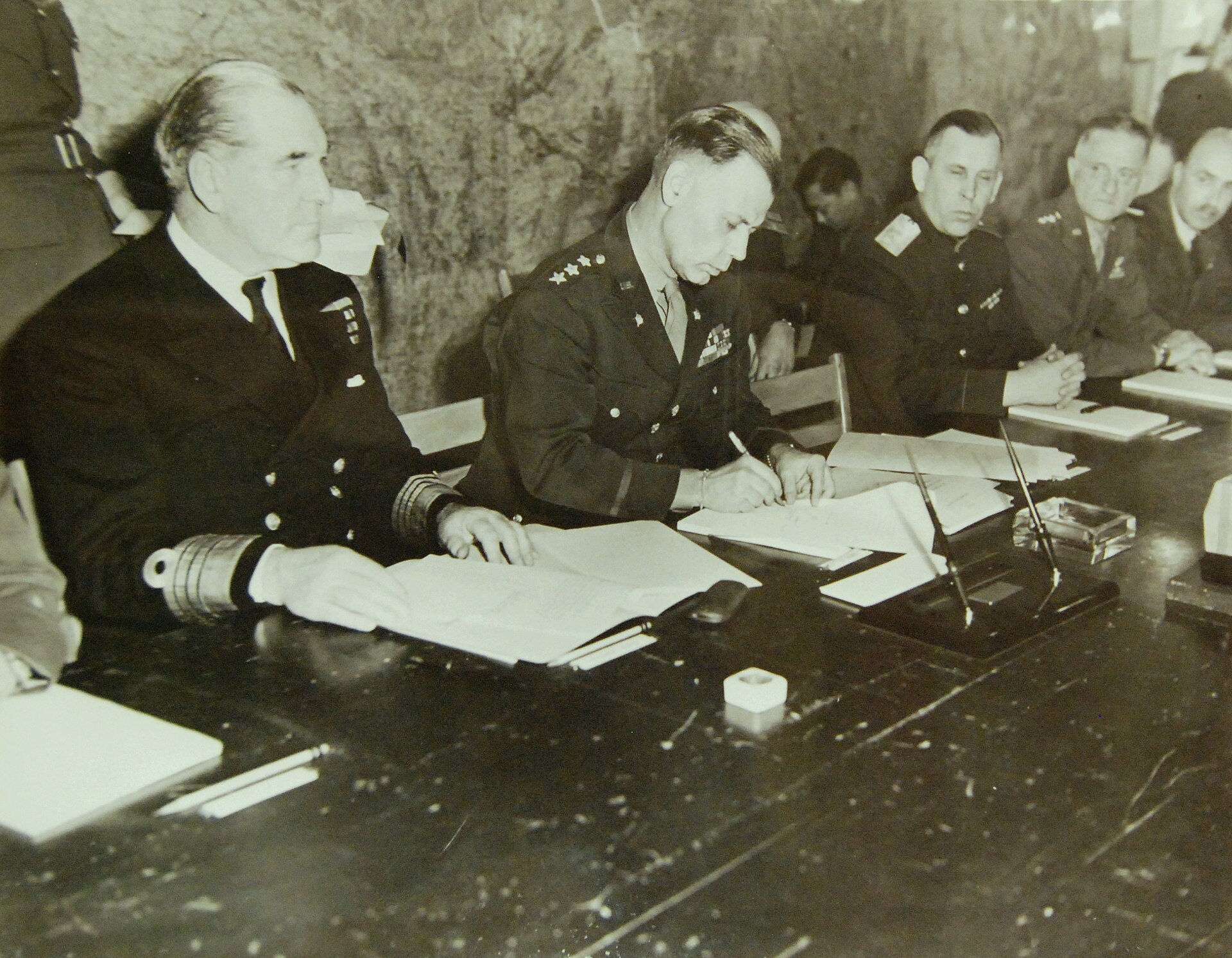The Revolutionary War ended in negotiation, with the 1784 ratification of the Treaty of Paris, about two years after British Gen. Lord Charles Cornwallis surrendered to Gen. George Washington on the Yorktown battlefield.
“Many wars end with just surrender,” said Richard H. Kohn, a University of North Carolina emeritus history professor.
“‘Negotiation’ suggests or implies very strongly that there’s a give and take,” Kohn said. “World War II was just a surrender — period — by both Germany and Japan.”
Vance’s office did not respond to an inquiry for this article.
The end of World War II
U.S. Lt. Gen. W.B. Smith affixes his signature to the unconditional surrender document after it was signed by the representatives of the German government at Reims, France, on May 7, 1945. (Public domain)
World War II’s two key war-ending events involved Germany, which unconditionally surrendered May 7 and 8, 1945, and Japan, which unconditionally surrendered Sept. 2, 1945.
Germany signed its surrender at Gen. Dwight D. Eisenhower’s headquarters in Reims, France, with representatives of the United States, the United Kingdom, the Soviet Union and France signing on behalf of the allies. At Soviet insistence, separate documents were signed in Berlin the following day, which the Soviets considered Germany’s official, legal surrender.
“We the undersigned, acting by authority of the German High Command, hereby surrender unconditionally to the Supreme Commander, Allied Expeditionary Forces and simultaneously to the Soviet High Command all forces on land, sea and in the air who are at this date under German control,” the document read in part.
Japanese Gen. Umezu Yoshijiro signs the surrender on behalf of the Imperial Japanese Army on board the USS Missouri in Tokyo Bay on Sept. 2, 1945. (Public domain)
Almost four months later, following the U.S. nuclear attacks on Hiroshima and Nagasaki, Japan also surrendered. U.S. Gen. Douglas MacArthur accepted the surrender on behalf of the U.S. and its allies.
Although the United States ultimately allowed Japan to keep its imperial throne, historians say it was not decided at the time of Japan’s surrender and was resolved later at the United States’ discretion.
“In the proceedings that ended the war, allied senior officers dictated surrender terms to both the Germans and the Japanese,” said John Coyne McManus, a professor of military history at the Missouri University of Science and Technology. “This was not a negotiation. It amounted to surrender instructions.”
The end of World War I
After the armistice ending World War I, German troops were disarmed by the Dutch. (Public domain)
The first stage of World War I’s end — a Nov. 11, 1918, armistice, or ceasefire — wasn’t an unconditional surrender, but the allies leaned heavily on Germany.
During armistice discussions, French Marshal Ferdinand Foch made small accommodations to Germany, such as letting the Germans keep some of their weapons. But agreement was tilted strongly against Germany, requiring it to give up 5,000 artillery pieces, 25,000 machine guns, 1,700 airplanes, 5,000 railroad locomotives, 5,000 trucks and 150,000 wagons, as well as the French territory of Alsace-Lorraine. Germany also agreed to an Allied occupation of German territory along the Rhine River.
The Treaty of Versailles, signed June 28, 1919, sealed the Allied victory with harsh terms.
In addition to losing both continental and overseas landholdings, Germany had to accept “war guilt” and make reparations to the allies, at an amount eventually set at $33 billion. The treaty permitted the allies to take punitive actions if Germany fell behind in its payments.
“There really was no significant negotiation with Germany in World War I,” Piehler said. “The armistice was essentially imposed on Germany, and Germany did not participate in the negotiations at Paris that led to the Treaty of Versailles. The German delegation had to take it or leave it.”
The end of ‘every major conflict in human history’
Roman soldiers attack the walls of Carthage during the siege that ended with the destruction of Carthage in 146 BC, by Sir Edward John Poynter, 1868. (Public domain)
Unconditional surrenders predate those by Germany in World Wars I and II and Japan in World War II, historians said. The Philippine-American War, the Invasion of Panama and the first Persian Gulf war were among those the U.S. has fought that ended in unconditional surrenders rather than negotiations, said David Silbey, a Cornell University historian.
One earlier example is the Third Punic War from 149-146 BCE, the third and final war between Rome and Carthage. Despite resistance by Carthaginians, Rome essentially annihilated its neighbor. Estimates suggest that only 50,000 of a quarter million residents survived to the surrender; they were sold into slavery, the city was destroyed, and Carthage became a Roman province.
The ending of the Civil War is a bit murkier. On the battlefield, Confederate general Robert E. Lee surrendered to the Union at Appomattox Court House, Virginia on April 9, 1865. That was followed by a series of additional surrenders by other commanders through November 1865.
These did not involve far-reaching negotiations. But President Abraham Lincoln indicated that he was open to further discussion on other issues beyond the nonnegotiable end to slavery, an ending of hostilities and recognition of the Union’s political supremacy. This took the pressure off Lee and other generals to negotiate on the battlefield.
Less than a week after Appamattox, Lincoln was assassinated.
Our ruling
Vance said, “If you go back to World War II, if you go back to World War I, if you go back to every major conflict in human history, they all end with some kind of negotiation.”
In World War II, both Germany and Japan surrendered unconditionally. As the World War I armistice was being negotiated, Germany won small concessions, but the allies generally imposed their will, an approach that strengthened with the Treaty of Versailles.
Other unconditional surrenders in history include the Third Punic War.
We rate the statement False.




